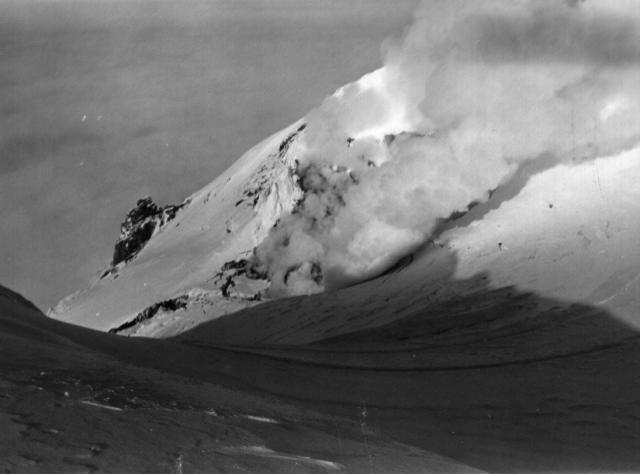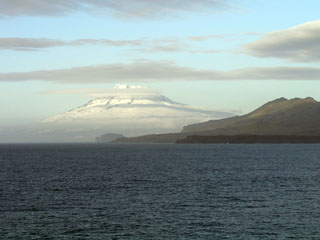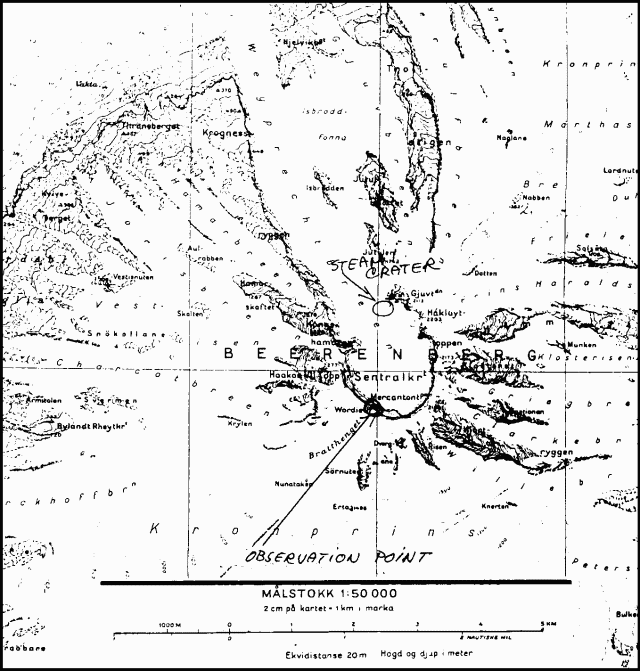Report on Jan Mayen (Norway) — March 1985
Scientific Event Alert Network Bulletin, vol. 10, no. 3 (March 1985)
Managing Editor: Lindsay McClelland.
Jan Mayen (Norway) Steam from new subglacial vent in central crater
Please cite this report as:
Global Volcanism Program, 1985. Report on Jan Mayen (Norway) (McClelland, L., ed.). Scientific Event Alert Network Bulletin, 10:3. Smithsonian Institution. https://doi.org/10.5479/si.GVP.SEAN198503-376010
Jan Mayen
Norway
71.082°N, 8.155°W; summit elev. 2197 m
All times are local (unless otherwise noted)
Weather conditions make observation of Beerenberg rare and difficult, but during clear weather on 3-4 April a steam column could be seen rising 400-500 m above the central crater rim. An expedition from the Jan Mayen Loran station climbed the volcano 7 April. Steam was rising from a new 300-m-wide subglacial vent (figure 1) within the central crater at 71.09°N, 8.17°W, in Weyprectbreen (Weyprect Glacier) near Gjuvtinden crag at 2,113 m altitude (figure 2). No activity was recorded by the Jan Mayen seismic array in early April. During an overflight 17 April, similar steam emission was observed. The pilot of the aircraft reported a strong sulfur smell. Two small craters in the January eruption area were emitting "smoke".
 |
Figure 1. Photograph showing steam emission on 7 April 1985 from Beerenburg's new central crater vent, looking N from the opposite side of the central crater rim. |
Loran station personnel estimated that the new central crater vent had developed within recent weeks. Very slight and apparently constant steam emission from Gjuvtinden has been observed since September 1971.
Geological Summary. Remote Jan Mayen Island, located in the Norwegian Sea along the Jan Mayen Ridge about 650 km NE of Iceland, consists of two volcanic complexes separated by a narrow isthmus. The large Beerenberg basaltic stratovolcano (Nord-Jan) forms the NE end of the 40-km-long island, which is ringed by high cliffs. The glacier-covered Beerenberg has a 1-km-wide summit crater and numerous cinder cones that were erupted along flank fissures. It is composed primarily of basaltic lava flows with minor amounts of tephra. Reported eruptions from Beerenberg date back to the 18th century. The SW tip of Jan Mayen contains the Holocene Sor-Jan cinder cones, tephra rings, and trachytic lava domes were erupted from short fissures with a NE-SW trend.
Information Contacts: K. Sandvik, P. Dalheim, R. Kirkemo, F. Moen, M. Gundersen, and T. Eliseussen, Loran Station, Jan Mayen.


